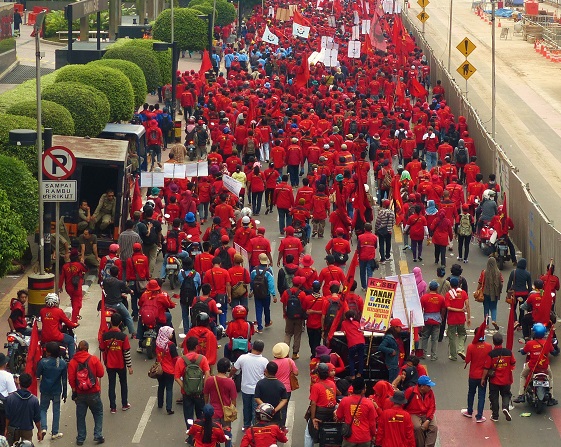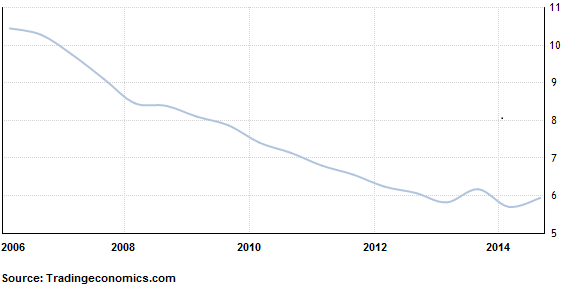Unemployment Rate of Indonesia Rises Slightly in August 2014
Amid slowing economic growth, Indonesia’s unemployment rate increased slightly in August 2014. On Wednesday (05/11), Statistics Indonesia announced that 7.24 million Indonesians, or 5.94 percent of the country’s labour force, were without a job. In the previous unemployment report (covering conditions in the month February 2014), Indonesia’s unemployment rate stood at 5.70 percent of the country’s labour force (about 7.15 million Indonesians). The government agency releases Indonesia’s unemployment data twice per year.

Amid robust economic growth in the past decade, Indonesia’s unemployment rate descended rapidly (after the country’s unemployment rate had accelerated sharply due to impact of the Asian Financial Crisis that had ravaged through the country in the late 1990s). However, when Indonesia’s economic expansion started to slow from 2011 onwards, the rapid downward pace of unemployment ceased. In the past two years, the country’s unemployment ratio has more or less moved sideways as slowing economic growth implies that fewer jobs are created in Southeast Asia’s largest economy. Therefore, President Joko Widodo - who assumed office on 20 October 2014 - is eager to push the country’s GDP growth to +7 percent (year-on-year, y/y) and is searching for structural reforms to accomplish his ambition.
Yesterday (05/11), it was reported that economic growth in Indonesia reached 5.01 percent (y/y) in the third quarter of 2014, the slowest quarterly growth pace in five years.
Indonesia's Unemployment Statistics 2010-2014:
| 2010 | 2011 | 2012 | 2013 | 2014¹ | |
| Labor Force | 116,527,546 | 119,399,375 | 120,320,000 | 120,170,000 | 121,870,000 |
| - Working | 108,207,767 | 111,281,744 | 113,010,000 | 112,760,000 | 114,630,000 |
| - Unemployed | 8,319,779 | 8,117,631 | 7,310,000 | 7,410,000 | 7,240,000 |
¹ data from August 2014
| 2006 | 2007 | 2008 | 2009 | 2010 | 2011 | 2012 | 2013 | 2014 | |
| Unemployment (% of total labor force) |
10.3 | 9.1 | 8.4 | 7.9 | 7.1 | 6.6 | 6.1 | 6.2 | 5.9 |
Source: Statistics Indonesia (BPS)
However, as Indonesia is the world’s fourth most populous country (containing a population that numbers around 250 million people) and has a young population (with about half of the population is below the age of 30 years), it is of vital importance that the Indonesian government can provide enough employment opportunities to its people. If not, then the demographic bonus of Indonesia can turn into a demographic disaster. Particularly high youth unemployment is a concern. Recently, the World Bank warned that the country’s high youth unemployment (aged between 15 to 24 years) can jeopardize social harmony in Indonesia.
Indonesia's Unemployment Rate 2006-2014 (percentage of labour force):

Equally important - and closely related to unemployment - is poverty. According to the latest data from Statistics Indonesia, 11.3 percent (nearly 30 million people) of the Indonesian population is currently poor. Moreover, around 68 million Indonesians live just above the poverty line and are therefore alarmingly vulnerable to fall (back) into poverty in times of shocks (for example sudden high inflation, job loss, natural disasters, etc). Enhancing GDP growth and providing more job opportunities will be an important task of the government in order to eradicate the nation’s poverty. Meanwhile, the government should keep a close eye on (in)equality. Based on research from various institutions (including the World Bank) inequality has been increasing in Indonesia in recent years, potentially disrupting the country’s social cohesion. Indonesia’s Gini coefficient, which measures income distribution inequality, grew from 0.30 in 2000, to 0.41 in 2013, while regional disparities persist. The eastern part of Indonesia lags behind the western part of the country, most notably Java. Consequently, Indonesia has one of the fastest rising rates of inequality in East Asia. During his campaign, President Widodo has repeatedly emphasized that social and economic development of Indonesia are his main targets. Earlier this week, he introduced the Indonesian Health Card (Kartu Indonesia Sehat, or KIS), Indonesian Smart Card (Kartu Indonesia Pintar, or KIP) and Indonesian Prosperous Card (Kartu Keluarga Sejahtera, or KKS) in an effort to support the poorer segments if Indonesian society. These programs aim to safeguard people’s purchasing power ahead of higher subsidized fuel prices. The government confirmed that prices of subsidized fuel (gasoline and diesel) will be raised this month. Analysts expected a significant price hike (perhaps up to 50 percent) in an attempt to curb the wide current account deficit and relieve the government’s budget deficit. However, a negative side-effect of this move is that it will trigger significantly accelerated inflation (for a period of three months) in Southeast Asia’s largest economy and thus poses a risk to the poorer households.
View Indonesia’s Unemployment Statistics
Key Findings:
• Indonesia’s unemployment rate increased slightly in August 2014 amid the country’s slowing economic growth
• Increasing unemployment, slowing poverty reduction and rising inequality form a threat to Indonesia as these issues may jeopardize social cohesion in Southeast Asia’s largest economy

